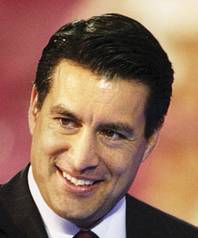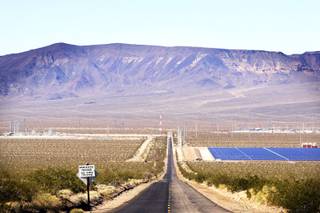
Copper Mountain Solar One, a thin film photovoltaic solar facility off U.S. 95 in Boulder City seen Thursday, February 10, 2011.
Sunday, April 3, 2011 | 2:01 a.m.

Brian Sandoval

Roger Tobler
archives
- Boulder City OKs deal for solar power plant (2-22-2011)
- Copper Mountain solar plant to be dedicated Friday (3-18-2011)
- New solar plant coming to Boulder City in $46 million deal (1-12-2011)
- The one unknown about proposed solar field: Cost of energy (12-23-2010)
- Sempra solar plant in Boulder City begins operation (12-2-2010)
- Large solar energy plant to be built near Boulder City (12-14-2010)
- Boulder City burned by failed solar field (10-25-2010)
- Boulder City sends SolBio letter of default for missed $3 million payment (10-13-2010)
- Solar plant in Boulder City gets $2.9 million grant (2-18-2010)
- Boulder City finalizes deal for third solar power plant (6-12-2009)
- Sempra to expand solar power plant near Boulder City (4-15-2009)
- Gibbons dedicates solar plant near Boulder City (1-22-2009)
- Another solar power plant in the works for Boulder City (1-19-2009)
- Solar power plant opens in Boulder City (1-5-2009)
- Solar firms seek land (12-24-2008)
Sun Coverage
Some statistics about Copper Mountain Solar, a 775,000-panel array outside Boulder City that went online last year as the largest photovoltaic solar plant in the United States, might seem surprising.
And not in a good way.
Temporary construction jobs created: 350. Not bad.
Nevadans employed: 262. That’s a good share.
Solar power coming to Nevada: 0. Zip.
Parts manufactured in Nevada: 0. Zilch.
Permanent jobs created: 5. That’s not a typo. State incentives developer Sempra Generation received: $12 million. That’s not a typo, either.
Gov. Brian Sandoval says the public money was well spent. “Every job is a great job,” Sandoval said when asked if the benefits of the project justify the incentives. “It’s the essence of what we are trying to accomplish here ... in terms of diversifying the economy and taking advantage of our renewable energy resources.”
State and federal leaders have homed in on renewable energy as a solution to Nevada’s economic morass. The state has abundant sunshine and land, and solar power companies have taken notice. With businesses fleeing the state and many company owners hesitant to move here, proposals from renewable energy firms with deep pockets and promises of job creation are certainly appealing.
But questions remain about what role government should play in the industry’s development, especially as figures from completed projects come to light. The quandary can be put this way: Is it worth spending tens of millions of taxpayer dollars to create only a handful of permanent jobs?
It’s a question state lawmakers asked in 2009, and answered with new legislation, after concerns about Sempra’s employment numbers surfaced. And although legislators say they feel more confident in the company and the checks-and-balances system created, the authority designated with oversight is proposed for closure.
•••
The federal government gave Sempra Generation about $42 million in tax credits, 30 percent of the price tag for Copper Mountain. The Economic Development Commission said the 48-megawatt project cost $141 million.
State officials provided sales tax abatements for equipment purchases and a 55 percent property tax reduction for 20 years. Those incentives amounted to $12 million. The state gave Sempra an additional $2 million in concessions for El Dorado, an adjacent 10-megawatt solar array.
“Even with the abatements, the state is still netting $27 million over the life of the project,” Sempra spokesman Scott Crider said. “This money would not be available to the state if not for the solar project.”
The cash comes from property and sales taxes Sempra pays at a reduced rate.
Similar incentives are offered to any renewable energy company that commits to a project that generates more than 10 megawatts of energy, enough to power several thousand homes. Firms also must abide by certain hiring and spending requirements to receive tax breaks.
“If they didn’t have the federal or state incentives, they probably couldn’t make these projects work,” Boulder City Mayor Roger Tobler said.
Boulder City profits greatly from Sempra’s projects because it owns the land the panels sit on. It will receive $60 million in lease payments from Sempra’s two existing solar arrays.
But the overall benefit to Nevada is questionable. Even Tobler, a staunch proponent of solar development, acknowledged the incentives are justified only “to a certain degree.”
Although Sempra hired 262 Nevadans to build Copper Mountain Solar (significantly more than the 30 percent local worker share the state requires), only five of those jobs remain.
The panel parts were manufactured by First Solar of Arizona, and that same out-of-town firm served as lead contractor on the project. The power generated at Copper Mountain will be transmitted to California for the next 20 years.
Sempra Generation is a subsidiary of Sempra Energy, which owns two Southern California utilities, natural gas pipelines and storage facilities in North and South America and wind farms in Indiana and Mexico. In 2010, it reported $9 billion in revenue.
Crider said Sempra solicited requests for proposals from panel manufacturers and energy buyers throughout the Southwest, including in Nevada. California utility Pacific Gas & Electric offered a higher price for the power than NV Energy.
California utilities are aggressively pursuing solar power because they must get 33 percent of their energy supply from renewable sources by 2020. (Nevada utilities are required to get 20 percent of their energy from renewables by 2015 and 25 percent by 2025.)
Boulder City’s location and infrastructure make transmission there easy. Boulder City has abundant open land for development and sits close to the grid, a benefit of its proximity to Hoover Dam.
•••
During the 2009 legislative session, Nevada lawmakers revamped the state’s renewable energy policy to make requirements more stringent for developers. They also made incentives more lucrative.
The change occurred after Assemblywoman Marilyn Kirkpatrick, D-North Las Vegas, testified that Sempra’s El Dorado project received a $1.8 million sales tax abatement while hiring only one Nevadan. The other workers came from out of state, she said.
Sempra also provoked the ire of the International Brotherhood of Electrical Workers for hiring nonunion electricians, who the union insisted were not properly certified to install photovoltaic panels. A Sempra spokesman said at the time he wasn’t aware of and couldn’t respond to those accusations.
The Legislature created the Renewable Energy and Energy Efficiency Authority to decide whether the financial benefits of a renewable energy project outweigh tax incentives offered. The authority reviews companies’ applications, conducts public hearings, and if conditions are met, grants abatements.
But less than two years after the authority was created, a measure is pending in the Legislature to eliminate it and move its duties to the state’s energy office.
To date, only six companies have gone through the authority’s review process, and none has been denied tax breaks (although one project was rejected at the local level), an energy office spokesman said. Nor have any developers been audited to confirm they are abiding by terms of their agreements.
Kirkpatrick said the law requires audits be done every two years, and the projects haven’t existed that long. She said it’s too early to issue a report card on the process.
Sempra applied for abatements before the energy authority was created so the Nevada Economic Development Commission reviewed its proposal. It was not subject to the reporting requirements legislated by the 2009 bill. Although other solar power companies must publicly outline abatements received, worker salaries and number of employees, Sempra does not. Still, Kirkpatrick said she is satisfied with the company’s hiring practices.
Sempra plans to extend its Boulder City solar footprint, and company officials acknowledge they will seek more government subsidies to do so. The Boulder City Council recently approved a Sempra proposal to more than quadruple its solar complex to produce an additional 200 megawatts of power.
Tobler said the new project should create 800 construction jobs, more than most roadway or sewer projects. But it’s unclear how many of those jobs would be permanent. Considering trends seen in other projects, it likely would be a couple dozen at most.
Lawmakers seem to be OK with that number.
Sun reporter Anjeanette Damon contributed to this story.


Join the Discussion:
Check this out for a full explanation of our conversion to the LiveFyre commenting system and instructions on how to sign up for an account.
Full comments policy